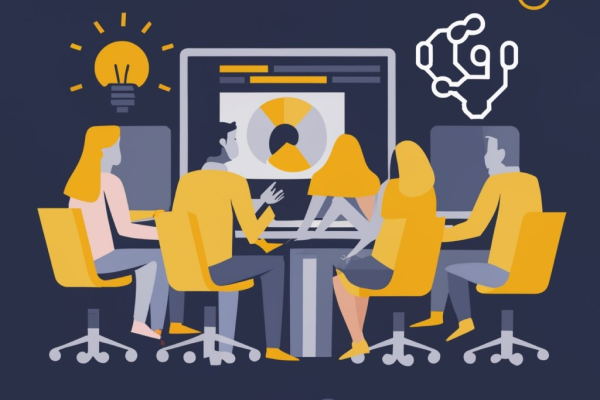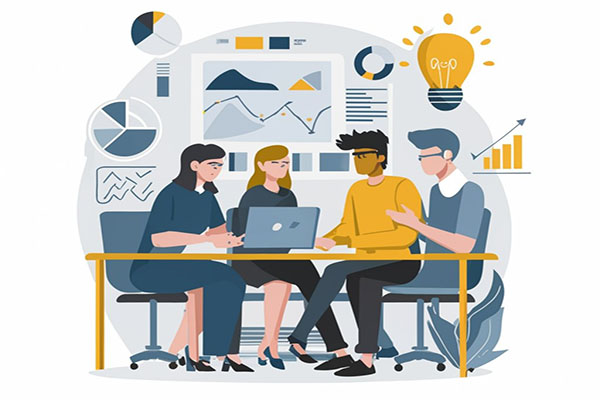
Ahead of the curve
Ready or not, generative AI is here—and it is rapidly transforming how Simon students learn, professors teach, and alumni create value. In the early 1990s, Simon installed the Bloomberg Terminal in its library at a time when the Internet was not yet in widespread use. Finance students quickly embraced the new electronic trading platform, using it to compete against each other in investment challenges. “I remember that we were one of the first institutions to install it,” says Manish Gupta ’94S (MBA), who worked in the library while earning his MBA. “Simon has always pushed to keep its students on the cutting edge of innovation.”
Some things never change, even as the entire world of business is transformed. Thirty years after the introduction of the Bloomberg Terminal, the release of ChatGPT triggered a seismic shift in the way we think, work, and learn. From the boardroom to the lecture hall, the seemingly limitless potential of generative AI has elicited a mixture of excitement, trepidation, and alarm.
Avoiding the twin pitfalls of unexamined enthusiasm and reactionary skepticism, Simon is thoughtfully embracing generative AI. Its newly launched generative AI initiative will ensure that students have the right blend of fundamental and specialized skills not just to use tools like ChatGPT, but to use them wisely. These students will soon join a family of alumni who is navigating the introduction of generative AI in a wide range of industries and functions.
Whether it is a student using generative AI as a next-generation tutor or an alum leveraging this technology to fill an unmet market need, the Simon community is working hard to stay ahead of the curve.
Getting up to speed
In 1967, the first handheld electronic calculator hit the market. Over the next decade, it began to appear in classrooms across the country, sparking heated debate over the proper role of technology in teaching mathematical reasoning. Today, problems that students once spent hours laboring over with pencil and paper are now easily solvable on a smartphone in seconds.
Generative AI is infinitely more powerful than a handheld calculator. While traditional AI systems are designed to recognize patterns and make predictions, generative AI tools like ChatGPT produce brand-new text, images, videos, and other media based on the data used to train it. Dan Keating ’05S (MBA), a clinical assistant professor whose teaching includes Business Modeling with Excel and Data-Driven Decision Making, was initially skeptical of the sweeping claims being made about generative AI’s capabilities.
“When the Internet came out, it was fairly skeletal,” he remembers. “You could see its potential, but it was clumsy. I expected generative AI to take a while to develop as well. I thought about AI-enabled predictive text on my cell phone, which always seems to get my kids’ names wrong, and assumed that ChatGPT would be pretty lousy at first. But then I used it.”
Keating was blown away by the sophistication of the first version of ChatGPT, released in November 2022. Before long, he was using it to develop a short list of speakers with expertise on a given subject, write course syllabi, and provide a high-level overview of a dataset. He wasn’t alone. Sevin Yeltekin, the dean of Simon Business School, uses ChatGPT to draft emails and review benchmarking data. Students began using it to streamline research and practice homework problems. For $20 a month, a newer iteration of ChatGPT can even write and execute code like a seasoned programmer.
There was never any question that Simon would embrace generative AI more quickly than most. “Simon has a long history of supporting and advancing educational innovation,” says Mitch Lovett, senior associate dean of education and innovation. Led by Keating, Simon’s Instructional Technology and Innovation (ITI) team was formed earlier this year to help faculty and staff navigate the sea of technological changes impacting higher education, including the rise of generative AI. Simon’s generative AI classroom use policy grants professors the freedom to assign a color—red, yellow, or green—to individual projects and exams. A red designation restricts the use of generative AI, a yellow designation requires explicit permission, and a green designation encourages students to use generative AI as needed. | “Simon has always pushed to keep its students on the cutting edge of innovation.”
—Manish Gupta ’94S (MBA) |
Most classes are a patchwork quilt of red, yellow, and green. In an introductory coding course that is required for Simon’s MS in Finance (MSF) program, for example, students will often be tasked with completing the first several parts of an assignment without any assistance. Then, as a learning tool, they can see how ChatGPT accomplished the same work. In a similar class within Simon’s MS in Marketing Analytics (MSMA) program, students are assigned a project that is too large to complete without ChatGPT. They use the tool to make the project feasible, but the objective is to prepare for an exam that is entirely handwritten.
“Students are finding that ChatGPT doesn’t just help them arrive at an answer, but it can augment their understanding by explaining how to get there,” says Keating. Starting in the pre-fall of 2023, Simon students participated in mandatory workshops that set expectations regarding the usage of generative AI and gave them a primer on prompt engineering—a skill that lays the foundation for using tools like ChatGPT to achieve the desired result. In addition to these workshops, MBA and analytics students will soon take a new AI & Business course that improves their ability to leverage business process improvement tools without having to rely on advanced coding skills.
“When we ask our new students who has used ChatGPT at one point or another, most hands go up,” says Keating. “But few of them have used it extensively. By the time they graduate, they need to know how to meaningfully incorporate AI into everything they do. These are skills that they need right now, not in the distant future.”
Managing transformation

In a recent survey of Simon alumni, nearly half of respondents reported “extensive” or “moderate” use of AI technologies within their organization. About a quarter reported frequent use in their personal roles. Data analysis, predictive analytics, and text generation were the most common applications, with ChatGPT being the most popular tool used. Two-thirds of respondents believe that AI will have a significant impact in their industry over the next five years.
Heavily regulated and slow-moving, the financial services sector has never been known for innovation. Alumni like Manish Gupta have spent their careers trying to change that. After graduating from Simon in 1994, Manish Gupta leveraged his MBA experience to pivot from engineering to global derivatives risk consulting. After a decade in consulting, he joined American Express’s risk and information management group, eventually working his way up the ladder to become the firm’s global head of information management and data products, big data, and advanced decisioning platforms.
Gupta and his colleagues had always made heavy use of modelling and analytics, and in 2010, they set off to transform the way they approached analytics, customer management, and underwriting using AI and machine learning.
“Introducing change in a highly regulated setting came with plenty of growing pains and roadblocks,” he remembers. “Imagine trying to get an Acela train running at 150 mph on tracks meant for trains going 70 or 80 miles per hour. That is what transforming a company’s infrastructure is like.” Everything needs to change rapidly: the firm needs to automate manual processes, change approval protocols, equip workers to use new tools, acquire more computing power, and work to remove biases in datasets used to train AI.
Gupta realized that if large, well-resourced companies like American Express were taking years to overcome all the hurdles inherent in integrating AI into their operations, smaller companies were facing an even steeper climb. He estimates that even today, only 10 percent of the financial services world uses AI in any meaningful capacity.
Corridor Platforms aim to move the needle. In partnership with several industry veterans who shared his expertise, Gupta founded Corridor Platforms in 2017 to help banks, credit unions, fintechs, and other industry stakeholders integrate analytical tools like AI into their risk and decision-making processes. A large language model (LLM), which forms the foundation of tools like ChatGPT, refers to the deep learning algorithm that can generate content. Corridor Platforms automates the pipeline of developing, implementing, and governing LLMs so that its clients can use generative AI effectively and responsibly in a variety of use cases, from making internal document review more efficient to serving as an “agent assist” that provides real-time suggestions to customer service representatives as they solve a customer’s problem.
“Generative AI is still experimental, in many ways, but the amount of work that has been accomplished with it in the past year is more than has been accomplished in the past decade,” says Gupta. “As an industry, we are advancing quickly.”
Building an experience

Like Gupta, Matt Bonaccorso ’05, ’07S (MBA) was drawn to AI early in his career. A lover of “choose your own adventure” activities as a child, he has always viewed coding as a gateway to creating engaging, open-ended experiences.
“I came to Simon because I knew that in addition to the technological and creative skills I had, I needed to learn how to get things done in business,” he reflects. After earning his MBA, he landed a digital products role at Nickelodeon, where he calls AI his “co-pilot in creation” as he led teams in developing new media and interactive toy technologies for children. He parlayed his experience into similar roles at ToyMail, which produced a kid-friendly WIFI toy messenger seen on SharkTank, and Warner Brothers Discovery, where he developed "Corbit the Robot,” which taught children math and science concepts through 60 hours of built-in programming. At 24 Watts, a creator of digital, multi-platform products, he led a team in developing an AI-powered robot called Cozmo that can express dozens of emotions and move its eyes in 250 ways.
“I have learned that kids have this innate creativity and curiosity that is not being leveraged,” says Bonaccorso. The robotic products he has helped develop are some of the few that have successfully combined storytelling, character development, and technology in a way that captures a child’s imagination.
Now, advances in generative AI are making it possible to create even more sophisticated products than what Bonaccorso helped create using first-generation AI products. In May 2023, he partnered with a gaming studio and a toy industry expert to co-found a brand-new company with a unique offering. Octagon AI, which anticipates the close of a funding round at the end of 2023, is developing an AI learning companion for children that blows its competitors out of the water.
The AI companion, named Milo, turns into a robot when plugged into a phone or tablet. “We’re offering an interactive video game experience that features a character with a backstory and a personality,” says Bonaccorso. Powered by generative AI, Milo will talk to his companion and personalize their experience based on what they share with him. He will explain a volcano differently to an eight-year-old than he would to a six-year-old, for example. Based on the child’s interests, he will ask questions that feel organic, not scripted. “Our AI companion lets kids live in their imagination, testing their ideas and concepts in a safe space,” says Bonaccorso. “We're excited to ignite their curiosity.”
A decade ago, only the Apples and Samsungs of the world would have had the resources to build out a product like Milo. Now, AI is opening new frontiers of possibility for creators like Bonaccorso. With a team of 10 developers, he will accomplish what would have taken 50 developers even a decade ago. From coding to generating ideas for fundraising, Bonaccorso and his partners have integrated AI into their company’s daily operations, not just their products. “Our company is AI building AI,” he says. “We are accelerating far more quickly than we could have even a few years ago.”
Creating value

Like most Simon alumni, Gupta and Bonaccorso earned their degrees long before the advent of generative AI. But both can draw a straight line between the foundation laid at Simon and the work they are doing today.
“Simon has always excelled at teaching the fundamentals,” Bonaccorso reflects. “When you know the fundamentals, you enter a situation and know how to handle it.” Gupta echoes this sentiment, pointing to the value of mastering basic building blocks of finance, accounting, marketing, and statistics in a rigorous academic setting. “The strength of a Simon student is their ability to take out a pen and paper and solve a problem,” he says. “This is key for future innovation.”
The generative AI workshops that Simon’s ITI team runs for faculty and staff emphasize the hazards of relying on tools like ChatGPT too heavily. Lovett points to recent research showing a 40% boost in productivity when someone knows when to use it, when not to use it, and how to discern biases. With ineffective use, productivity can actually decline.
A quick online search will uncover dozens of examples of ChatGPT “hallucinating,” or producing answers that sound reasonable but are inaccurate or lacking in nuance. To recognize a crooked line, a student must first know what a straight line looks like. In the same way, they must approach generative AI with enough background knowledge to know when it is glitching. “The working world will be most favorable to those who can use generative AI tools effectively and productively while at the same time possessing the domain knowledge to assess, correct, and fine tune what is being generated,” says Dean Yeltekin. And while generative AI may reduce the struggle of completing an onerous assignment, overuse will diminish opportunities for building foundational skills. “There is no better substitute for struggling with an idea and working your way through a problem where the answer is not quite clear,” says Keating. “That is where the learning happens.”
Whether it’s how to recruit ChatGPT to serve as a useful teaching assistant or how to uphold academic integrity in a variety of use cases, plenty of tough questions lie ahead. But for Simon’s faculty, staff, and students, avoiding them is not an option.
“Every career that a Simon student pursues will be impacted by generative AI,” says Lovett. “Even if someone doesn't use AI in their daily work, they will inevitably interface with people who do. AI will be central to creating value, so we will continue working to help students and alumni create value over the long arc of their careers, wherever they end up.”
Editor's Note: All images in this article were created using generative AI.
